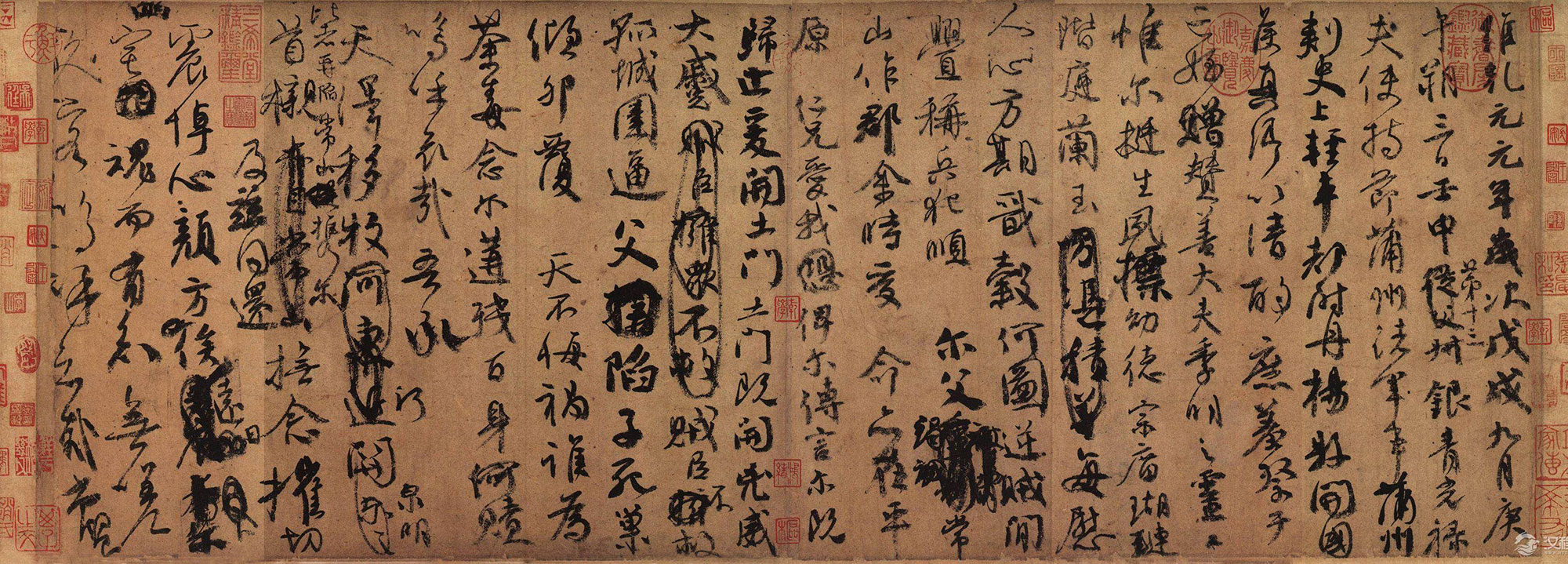Tears in Ink: Exploring Yan Zhenqing's Heartbreaking Draft of a Requiem to My Nephew
|
In the vast landscape of Chinese calligraphy, certain works transcend mere artistic skill, resonating with profound human emotion. One such piece is Yan Zhenqing’s Ji Zhi Wen Gao (祭侄文稿), often translated as Draft of a Requiem to My Nephew or Draft of a Memorial to My Nephew. This intensely personal and emotionally charged work is not just a masterpiece of calligraphy but also a poignant testament to grief, loyalty, and the ravages of war.
Created in 758 AD, during the An Lushan Rebellion, the Draft of a Requiem to My Nephew is a memorial written by Yan Zhenqing to his nephew, Yan Jiming, who was killed in the fighting against the rebels. Unlike other calligraphic works intended for public display or aesthetic appreciation, this piece was initially a private, deeply felt expression of mourning. The rawness and immediacy of the writing give it a unique power that continues to move viewers centuries later. The story behind the work is heartbreaking. The Yan family, staunch loyalists to the Tang Dynasty, was deeply impacted by the rebellion. Yan Zhenqing himself served as a military commander, and his family faced extreme dangers. His nephew, Yan Jiming, was a young, brave warrior who was brutally murdered. The draft memorial was written in a fit of grief and outrage, an act of remembrance and a cry of pain. What makes the Draft of a Requiem to My Nephew so compelling is the way Yan Zhenqing's emotions are palpable in every stroke of the brush. He wrote using the running script (行書, xingshu), but unlike the smooth, flowing lines of Wang Xizhi's Lanting Xu, Yan Zhenqing's characters are often jagged, abrupt, and forceful. There’s a sense of urgency and raw honesty in the brushwork. Ink runs thick and thin, and the characters vary greatly in size and shape, revealing the artist's turmoil. The composition itself reflects the fragmented state of mind Yan Zhenqing must have been in. The text is somewhat chaotic, with lines crossed out and rewritten, reflecting the spontaneous and unrehearsed nature of the writing. Some characters are bold and pronounced, while others are almost faint, creating a powerful visual representation of grief’s fluctuating intensity. The layout is unpolished, with the text occasionally veering off course, resembling a torrent of emotions released onto paper. The content of the memorial is equally moving. Yan Zhenqing laments the loss of his nephew and the horrors of war. He speaks of the bravery of his family, the cruelty of the rebels, and the despair of the times. The words, although not meant for formal presentation, are infused with the powerful conviction of a man who has suffered a profound loss. It’s a raw and immediate expression of personal pain within a larger historical context. It is precisely the imperfection and unrestrained emotion of the Draft of a Requiem to My Nephew that make it so unforgettable. It stands in sharp contrast to more polished calligraphic works. It does not strive for conventional beauty, but instead conveys genuine human feeling with an astonishing and visceral force. Yan Zhenqing's Draft of a Requiem to My Nephew is not just a piece of calligraphy; it's a historical document, a personal testament, and a raw outpouring of grief and loyalty. It captures a pivotal moment in Chinese history and reminds us of the profound connection between art, emotion, and the human experience. It remains a timeless testament to the power of art to give voice to unspeakable loss and to preserve the memory of those we love. The work continues to move viewers, serving as a poignant reminder of the impact of war and the enduring power of human emotion in the face of tragedy. |
Tag : Ji Zhi Wen Gao,Yan Zhenqing
Related information
- The Importance of Rhythm in Running Script
- Running Script and its Use in Typography and Font Design
- The Concept of "Brush Intent" in Running Script
- Running Script and the Evolution of Personal Style Over Time
- The Role of the Inkstone in Running Script Practice
This article emphasizes the importance of rhythm in Running Script, exploring how stroke weight, connections, and negative space contribute to the overall flow and expressiveness of the artwork.
This article explores the influence of Running Script on typography and font design, highlighting how its flowing lines, connecting strokes, stroke variations, and use of negative space have inspired innovative and visually appealing modern typefaces.
This article focuses on the concept of "brush intent" (bǐyì) in Running Script, explaining how it reflects a calligrapher’s unique personality, inner feelings, and vision through the expressiveness of their brushstrokes.
This article explores the evolution of personal style in Running Script over time, highlighting how a calligrapher’s style is shaped by experience, technique, emotional growth, and a lifelong commitment to the art form.
This article highlights the importance of the inkstone in Running Script practice, showcasing its role in ink preparation, the meditative process of grinding ink, and its connection to the tradition of Chinese calligraphy.
